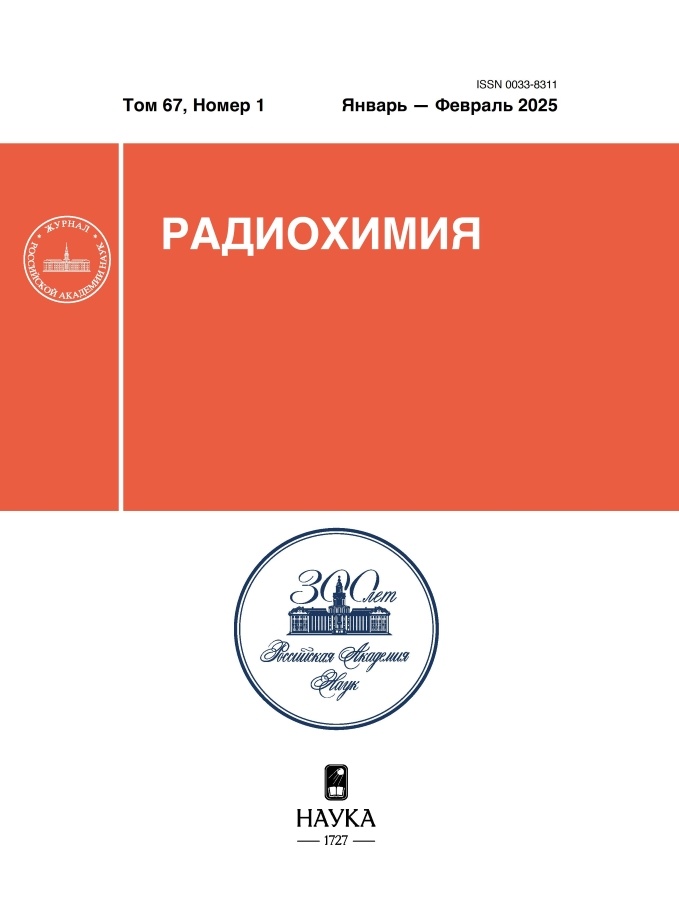Reaction of nitrate ion with formic acid in the presence of uranium
- Authors: Krasnikov L.V.1, Lumpov A.A.1, Semenova N.A.1
-
Affiliations:
- Khlopin Radium Institute
- Issue: Vol 67, No 1 (2025)
- Pages: 10-17
- Section: Articles
- URL: https://ter-arkhiv.ru/0033-8311/article/view/689433
- DOI: https://doi.org/10.31857/S0033831125010026
- ID: 689433
Cite item
Abstract
The reaction of nitric acid with formic acid, including uranium-containing solutions, was studied. Empirical equations for the dependence of the induction period duration (τ) on the concentrations of reagents and temperature were determined. The dependence of τ on the concentration of formic acid is exponential. The effect of uranium concentration on τ in denitrated solutions becomes noticeable only at temperatures lower than 60°C. The main factor affecting the completeness of denitration is the molar ratio [formic acid] : [NO3]¯. Starting with the molar ratio of ≥3, uranium-containing solutions are denitrated at 90°C in an hour almost quantitatively. The resulting uranyl formate is partially precipitated. The initial stage of the reaction is accompanied by violent gas evolution. At 90°C, ~80% of the gas volume is released at this stage (about 10 s), whereas at 40°C, only ~10%.
The reaction of nitric acid with formic acid, including uranium-containing solutions, was studied. Empirical equations for the dependence of the induction period duration (τ) on the concentrations of reagents and temperature were determined. The dependence of τ on the concentration of formic acid is exponential. The effect of uranium concentration on τ in denitrated solutions becomes noticeable only at temperatures lower than 60°C. The main factor affecting the completeness of denitration is the molar ratio [formic acid] : [NO3]¯. Starting with the molar ratio of ≥3, uranium-containing solutions are denitrated at 90°C in an hour almost quantitatively. The resulting uranyl formate is partially precipitated. The initial stage of the reaction is accompanied by violent gas evolution. At 90°C, ~80% of the gas volume is released at this stage (about 10 s), whereas at 40°C, only ~10%.
Keywords
Full Text
About the authors
L. V. Krasnikov
Khlopin Radium Institute
Author for correspondence.
Email: lkrasnikov@khlopin.ru
Russian Federation, 2-i Murinskii pr. 28, St. Petersburg, 194021
A. A. Lumpov
Khlopin Radium Institute
Email: lkrasnikov@khlopin.ru
Russian Federation, 2-i Murinskii pr. 28, St. Petersburg, 194021
N. A. Semenova
Khlopin Radium Institute
Email: lkrasnikov@khlopin.ru
Russian Federation, 2-i Murinskii pr. 28, St. Petersburg, 194021
References
- Longstaff J.V.L., Singer K. // J. Chem. Soc. 1954. P. 2610–2617.
- Kelm M., Oser B., Drobnik S. // Denitration of Radioactive Liquid Waste / Eds L. Cecille, S. Halaszovich. Dordrecht: Springer, 1986. P. 86–96.
- Lee E.H., Hwang D.S., Kim K.W., Kwon S.G., Yoo J.H. // J. Korean Ind. Eng. Chem. 1997. Vol. 8. N l. P. 132–139.
- Ando M., Fujita M., Izato Yu-ichiro, Miyake A. // Process Safety Environ. Protect. 2021. Vol. 151. P. 182.
- Bradley R.F., Goodlett C.B. // USAEC Report DP-1299. Du Pont de Nemours and Company, 1972. P. 48.
- Orebaugh E.G. Denitration of Savannah River Plant Waste Streams. SC (the United States): Savannah River Lab. Aiken, 1976. 26 p.
- Kubota M., Yamaguchi I., Nakamura H. // J. Nucl. Sci. Technol. 1979. Vol. 16. P. 426–433.
- Lee E.H., Hwang D.S., Kim K.W., Shin Y.J., Yoo J.H. // J. Korean Ind. Eng. Chem. 1995. Vol. 6. N 3. P. 406–411.
- Hwang D.S., Lee E.H., Kim K.W., Lee K.I., Park J.H., Yoo J.H., Park S.J. // J. Industrial and Engineering Chemistry. 1999. Vol. 5. N 1. P. 45–51.
- Holze K., Finke H.-D., Kelm M., Deckwe W.-D. // Сhem. Ing. Tech. 1979. Vol. 51. N 7. P. 754–755.
- Красников Л.В., Лумпов А.А., Мурзин А.А., Семенова Н.А. Патент RU 2494479 C1. 2012.
- Алой А.С., Самойлов С.Е., Кольцова Т.И., Металиди М.М., Рябков Д.В., Безносюк В.И. и др. Патент RU 2702095 C1. 2018.
- Алой А.С., Абашкин А.Ю., Карпович Н.Ф., Кольцова Т.И., Красников Л.В., Мурзин А.А. и др. // Вопр. радиац. безопасности. 2021. № 3 (103). С. 35–46.
- Алой А.С., Абашкин А.Ю., Исмаилов Р.В., Кольцова Т.И., Мурзин А.А., Сапрыкин В.Ф., Хоршев А.А. // Хим. технология. 2023. Т. 24. № 1. С. 26–32.
- Алой А.С., Вергазов К.Ю., Горбачев М.В., Давыдов А.В., Исмаилов Р.В., Орлова В.А., Серебрянских Р.А. // Радиохимия. 2024. Т. 66. № 6. С. 528–537.
- Cecille L., Kelm M. // Denitration of Radioactive Liquid Waste / Eds L. Cecille, S. Halaszovich. Dordrecht: Springer, 1986. P. 11–31.
- Родионов С.А., Сапрыкин В.Ф., Савин Р.А., Металиди М.М., Николаев А.Ю., Красников Л.В., Рябков Д.В. // Тез. докл. VIII Всерос. конф. по радиохимии. Железногорск, 28.09–02.10.2015 г. М.: Наука, 2015. С. 207.
Supplementary files


















